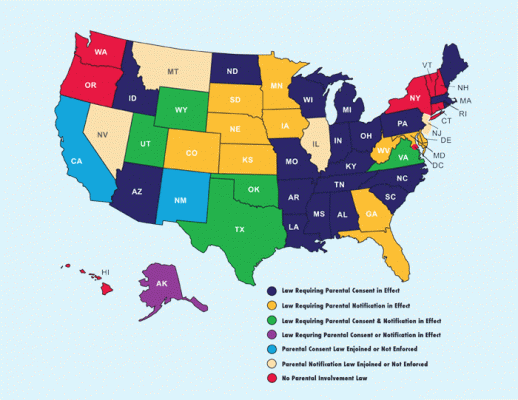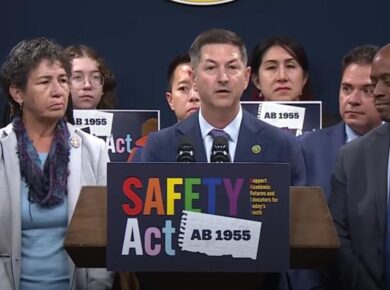Last week marked the 43rd anniversary of the Supreme Court’s decision in Roe v. Wade. And while that ruling made abortion legal nationwide, it also allowed states to regulate abortion, to a certain extent. Since Roe was decided in 1973, states have passed their own abortion laws, some of which require parental notification for minors, mandate waiting periods or counseling prior to the procedure, and restrict late term abortions.
And, as recent cases have shown, not only do these laws vary greatly by state, but they are almost constantly in flux. In fact, the Court will be hearing arguments on Texas’s restrictive abortion laws this March. So where do these laws stand now, and are they likely to change?
Waiting Periods
Almost half the states have some waiting period before a woman can receive an abortion, most being 24 hours. Indiana and South Carolina have waiting periods of less than 24 hours, but Missouri, North Carolina, Oklahoma, South Dakota, and Utah have 72-hour waiting periods. California, Florida, and New York have no waiting period at all.
Mandatory Counseling
While every state requires a woman giver her informed consent to an abortion, but the definition of “informed” can differ from state to state. 38 states require some form of counseling before an abortion is performed, and five of them (Indiana, Louisiana, Mississippi, Utah, and Wisconsin) require the counseling to be done in person.
Much of the counseling has to do with the procedure itself, but some states require notice about fetal development and the gestational age of the fetus. Twelve states require information on the ability of the fetus to feel pain, and Indiana, Kansas, Missouri, Oklahoma, and North and South Dakota require a woman to be told that personhood begins at conception.
Parental Notice and Consent
For women under the age of 18 seeking an abortion, 38 states require parental involvement in some fashion. Some of those states only require that one parent be notified of the procedure, though Minnesota requires prior notification for both parents. Twenty-one states require consent from one parent, and Kansas, Mississippi, and North Dakota require both parents to consent. And Oklahoma, Texas, Utah, Virginia, and Wyoming require parental notification and consent prior to an abortion.
However, states may not give absolute veto power to parents, so they must provide an alternate procedure for minors to obtain court approval for an abortion without parental notice or consent. In some states, judges must take into account the minor’s intelligence, emotional development and stability, and her understanding of the procedure and possible consequences before waiving parental involvement requirements. Although, these requirements can also be waived if the minor is a victim of abuse or neglect.
Ultrasounds
Many states have begun requiring women to undergo pre-abortion ultrasounds, and in some cases, must view the ultrasound as well. Louisiana, Texas, and Wisconsin mandate that abortion providers show and describe the image of the ultrasound to each woman seeking an abortion, while ten other states require providers to offer a woman the opportunity to view the ultrasound image.
There is a current split on the legality of ultrasound laws. While the Fourth Circuit recently invalidated a North Carolina law requiring physicians conducting ultrasounds to describe the fetus in detail, including its dimensions and the presence of external members and internal organs. Meanwhile, the Fifth and Eighth Circuits have allowed similar laws to stand. The Supreme Court passed on reviewing the Fourth Circuit decision, meaning that ultrasound laws will continue to differ from state to state.
Gestational Limits
Perhaps the most hotly contested issue with abortions has been when it’s too late to get one. Roe v. Wade determined that the state’s interest in protecting a fetus begins at “viability,” and 21 states prohibit abortions at fetal viability. Viability is defined as when the fetus can survive outside of the womb, but determining an exact date of viability has proven difficult, if not impossible. Viability is treated as a medical concept, and although medical advances have shifted and could continue to shift this determination, it is typically held to be the 24th or 25th week of pregnancy.
Other states tie prohibitions to a specific date. Iowa, South Carolina, and Virginia ban abortions during the third trimester of pregnancy. And 19 states base their prohibitions on the week of pregnancy: 10 ban abortions after 20 weeks post fertilization, two after 22 weeks, and seven after 24 weeks.
Other prohibitions have been attempted based on gestational benchmarks like the fetus’s ability to feel pain, or when a fetal heartbeat can first be detected. But a recent Arkansas ban on abortions after 12 weeks based on a detectable heartbeat was recently ruled unconstitutional.
Doctor and Hospital Requirements
Another recent point of contention has been state requirements for physician licensing and admitting privileges at hospitals in order to perform abortions. For instance, Mississippi requires the clinician to be either a board-certified OBGYN or eligible for certification in order to perform the procedure.
14 states mandate that abortion providers must have some affiliation with a local hospital, and Missouri, North Dakota, Tennessee, Texas, and Wisconsin require that providers have admitting privileges in a local hospital. Hospitals have in turned denied admitting privileges to doctors who perform abortions, severely restriction access to abortions in some states. Texas’s law has been challenged, and the Supreme Court will hear arguments on the case this March.
Not all states regulate abortions in the same way, and certain laws are subject to change. If you’d like to know the law in your state, or are having trouble accessing abortion services, you can contact an experienced family law attorney near you.










